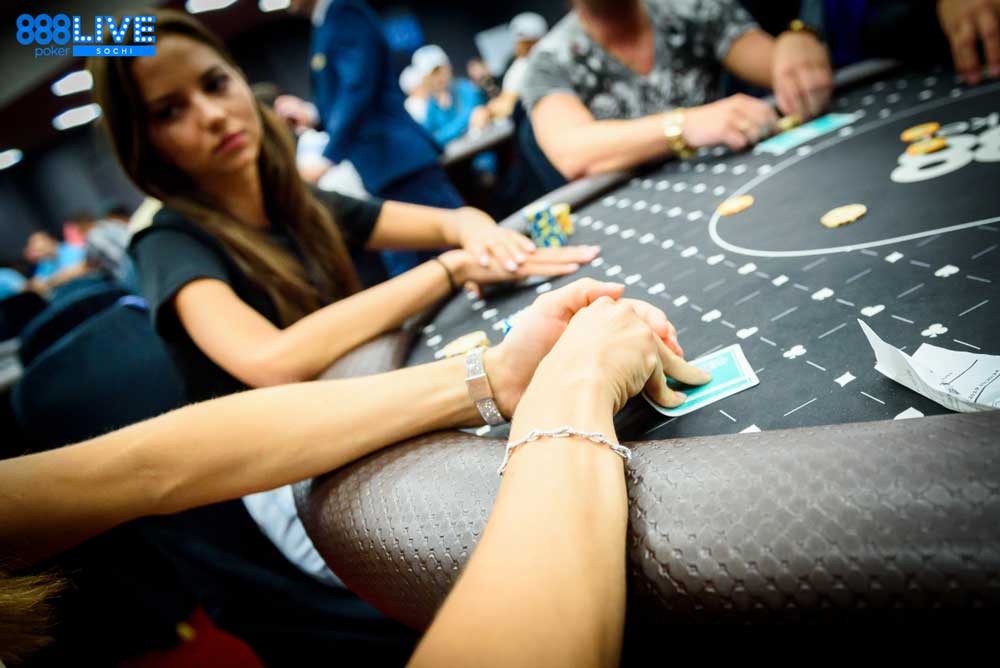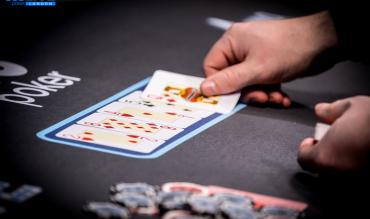So we’ve check/raised the turn while out of position – now what? Should we bet the river? If so, which hands make sense? Should we ever check/raise the river after check/raising the turn?
If you are confused about what to do on the river after check/raising the turn, you are no different than the vast majority of poker players.
With the help of a sample poker hand we will answer some of the most common questions regarding river play after check/raising the turn.
Let’s take a look at our list of questions:
- Should we bluff the river after check/raising the turn?
- Which types of hands make sense to bluff with?
- Which sizing should we use when bluffing the river?
- How often should we bluff the river after check/raising the turn?
- How wide can we value bet the river after check/raising the turn?
- Which bet sizing should we use when value-betting the river?
- How do we play mid-strength hands on the river after check/raising the turn?
- What happens if we bet our mid-strength hands on the river?
- Should we ever trap the river after check/raising the turn?
- Should we ever check/raise bluff the river after check/raising the turn?
Example Hand
Although there are countless ways that we can reach the river after check/raising turn, we’ll use the following sample hand to help us answer our river play questions.
200bb effective stacks.
BTN opens to 2.5bb.
BB cold-calls.
Flop: Th9h5d (Pot 5.5bb)
BB checks.
BTN cbets 4.25bb.
BB calls 4.25bb.
Turn: 6h (14bb)
BB checks.
BTN bets 10bb
BB raises to 27bb
BTN calls 17bb
River: 2c (68bb)
BB?
Take a moment to think through the hand and decide –
- Which hands would you check/raise the turn?
- How would you play those hands on the river?
Let’s look at our questions.
Q1 – Should we bluff the river after check/raising the turn?
Theoretically, the answer to this question is a definite yes. Since we will be firing strong hands for value on the river, our gameplan can become very transparent if we never show up with a bluff.
In practice, it depends on our opponent. For example, if our opponent is folding the river less than he is supposed to, it may be correct for us to never bluff.
Q2 – Which types of hands make sense to bluff with?
We should consider bluffing with hands that don’t have showdown value. This usually means our final hand on the river is king high or worse.
As an example taken from our sample hand, BB should be firing the river with KhQs after check/raising the turn. Although this hand has a flush-draw + gutshot + overcards on the turn, everything misses on a 2c river leaving us with king high.
Although it may sometimes be correct to turn an ace high or low pair type hand into a bluff, this should happen quite rarely according to poker theory. In practice we might use these types of hands as bluffs more often if our opponent tends to fold the river more frequently than he is supposed to.

Q3 – Which sizing should we use when bluffing the river?
The simple answer is that we should be using a range of different bet-sizings when bluffing the river. This is because our value hands will also use a range of different bet-sizings based on their strength. If we always use the same bet-sizing when bluffing our gameplan might become overly transparent.
This is not to say that all bet-sizings are equal. The most commonly used bet-sizings should depend on the board runout, especially the river card. We often find that river cards which complete lots of draws incentivize smaller bet sizings while river cards that brick incentivize larger sizings (at least in this scenario).
In our sample hand, the most common sizing selected by a poker solver is a 150% pot overbet (102bb). However, if we change the river card to the 7h, the most common sizing changes to 10% pot (6.8bb).
Q4 – How often should we bluff the river after check/raising the turn?
In theory, there is a limit to how often we should fire the river with a busted draw as a bluff. For every value hand we bet, we should have a set number of bluffs that also bet in that same scenario. This is a concept that poker players refer to as bluff to value ratio.
The theoretically correct bluff to value ratio depends on the river bet-sizing. As an example, if we make a pot sized bet on the river, we are allowed to bluff once for every two value bets.
In most cases, if fired all of our busted draws, we would be bluffing too frequently according to poker theory. This is referred to as overbluffing in poker.
Despite this, it often makes sense to fire all of our busted draws regardless. This is because the average opponent is usually folding too much to a river bet after calling a turn check/raise. We only care about having a correct bluff to value ratio if our opponent is skilled enough to exploit us if our ratio is unbalanced.
Q5 – How wide can we value-bet the river after check raising the turn?
In our sample hand, we need a set or better in order to value bet the river.
However, it’s important to recognize that it depends heavily on the board runout and exact action.
One reason our value-betting range is so tight in the sample hand is because a possible heart flush completes on the 6h turn. If we change the 6h turn to a 6c turn, then two pair type hands are strong enough to value bet the river.
If we change the river card to a heavy draw-completing 8h then only the absolute strongest flushes can value bet.
Q6 – Which bet-sizing should we use when value-betting the river?
Similar to bluff sizing, we should use a selection of different river value-bet sizings depending on the strength of our hand.
For the most part, it’s as simple as using larger bet sizings for stronger hands. In our sample hand, sets and straights bet small whereas flushes bet larger (often for an overbet sizing).
The only theoretical caveat here is that very strong hands should also sometimes bet the river small. We don’t want our opponent to easily infer that we are not that strong every time we use a small bet-sizing.
In practice many opponents are non-observant which means that protecting our smaller bet-sizings with strong hands is not necessary. Doing so could damage our winrate since we are no longer extracting the maximum possible value with our strongest hands.
Q7 – How do we play mid-strength hands on the river after check/raising the turn?
The simple answer is that we should always be checking mid-strength hands such as mid/top pair (and two-pair if a flush is possible). However, it’s worth thinking about this in a little more depth.
We don’t have medium strength hands on the river too often after check/raising the turn, but we do have them sometimes. One reason is simply that the river card might improve many of our draws to mid-strength hands. This is not the case in our sample hand however, since the turn 2c does not connect with any of our turn check/raise semi-bluffing region.
Despite this we still have medium strength hands in our sample hand because poker theory occasionally check/raises the turn with pair + gutshot type hands such as 97/98/T8/T7 along with some second pairs such as Tx or 9x.
It's worth noting that this doesn’t happen very often and that the majority of our turn check/raises in the sample hand are one-card flush draws with or without an accompanying straight draw. Theory also occasionally check/raises T9 (two pair) on the turn which should be considered a mid-strength hand by the river since it is not strong enough to fire the river for value.
If we face a river bet after checking, we need to decide between folding or bluffcatching (calling). Many hands might be mixed between both options. For example, in our sample hand, theory sometimes check/calls T7s and sometimes check/folds.
Q8 – What happens if we bet our mid-strength hands on the river?
The short answer is that we will usually still make money but we are not taking the most profitable line overall.
While both betting and checking mid-strength hands usually ends up being profitable, checking a mid-strength hand makes more money than betting. Betting technically “loses” us money since we could have earned more by checking.
Q9 – Should we ever trap the river after check/raising the turn?
The theoretical answer to this question is yes. In our sample hand a poker solver takes ace-high and king-high flushes and sometimes attempts to check/raise the river for value rather than betting.
If we only ever check busted draws and mid-strength hands on the river our check/raise bluffs might become transparent against observant opponents since we are never taking this same line with a value hand.
In practice, it may make sense to always fire the river with value hands rather than trapping. This is especially true against passive opponents who won’t bet the river frequently when checked to.
Q10 – Should we ever check/raise bluff the river after check/raising the turn?
Yes, although many players have never used this line even once in their entire career.
In theory, we especially like check/raising with holdings that make it less likely our opponent has a strong hand (aka blockers). In our sample hands, this usually means holding one heart along with a card that would formulate part of the T-high straight.
Example check/raise bluffs include the 77 with the 7h and T8/98 with one heart. When we hold a seven, eight or heart, it makes it less likely that our opponent has either a flush or the T-high straight. This is a concept referred to as card removal effect or blockers.
Getting Started
Strong Hands
- Fire the river for value with strong hands, usually sets or two-pair plus depending on the runout.
- The stronger the value hand, the larger the sizing should be.
- Although we should technically sometimes bet small with strong hands, this is not necessary vs the majority of opponents and may make our winrate worse.
Mid Strength Hands
- These should always check the river.
- When facing a bet they choose between check/call bluff catching, check/folding, or check/raising as a bluff.
Weak Hands (i.e. busted draws)
- We should bluff with a selection of our busted draws.
- We might regulate our bluff to value ratio vs advanced opponents.
- Assuming we don’t bluff we should check/fold (although these hands may also check/raise bluff depending on the card removal effects).
Summary
Mastering river play in poker is a pivotal skill that can greatly impact your overall success at the table. By understanding when to bluff, how to value bet, and how to navigate mid-strength hands after check/raising the turn, you'll gain a strategic edge. Remember, the key lies in adapting these strategies to the unique dynamics of each game and opponent. With practice and experience, you can refine your river play and make more informed decisions that lead to increased profitability in your poker journey.


